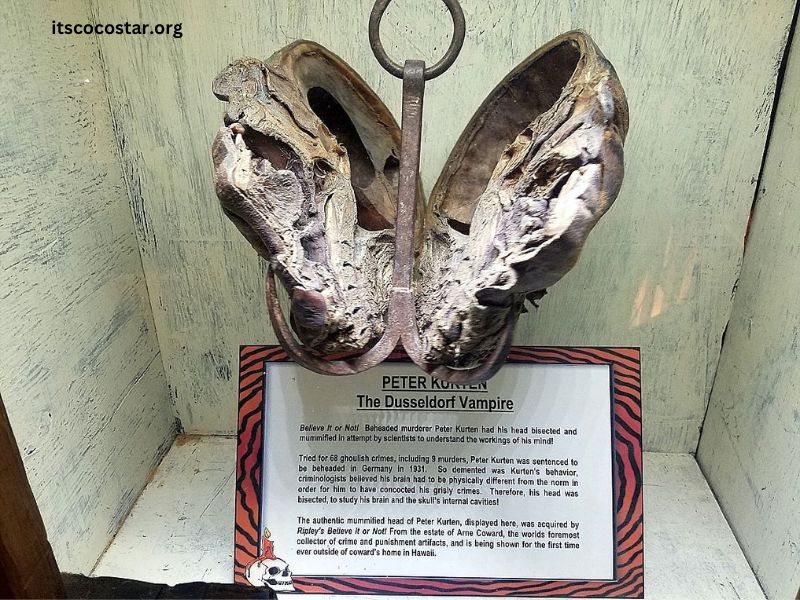Peter Kürten, infamously known as the “Vampire of Düsseldorf,” was one of the most notorious serial killers in Germany’s history. His reign of terror in the late 1920s left an indelible mark on the city of Düsseldorf and the annals of criminal history. This article delves into the life, crimes, and psychological profile of Kürten, exploring how his childhood, actions, and eventual capture shaped the legacy of one of the most feared criminals of the 20th century.
Early Life and Background
Peter Kürten was born on May 26, 1883, in Mülheim am Rhein, a suburb of Cologne, Germany. He was the third of thirteen children in a family plagued by poverty, violence, and neglect. His father, a severe alcoholic, subjected his family to regular beatings and abuse. The family’s dire financial situation forced them to live in a cramped, one-room apartment, exacerbating the tension and violence within the household.
Kürten’s early life was marred by exposure to brutality and crime. By the age of nine, he had already committed his first act of violence, drowning two of his schoolmates in a river. This incident, which he managed to cover up as an accident, marked the beginning of his long and terrifying criminal career. His early exposure to violence and crime played a crucial role in shaping his later behavior, instilling in him a deep-seated fascination with death and suffering.
At the age of 16, Kürten left home to escape his father’s abuse and embarked on a life of petty crime. He was frequently in and out of prison, where he learned more about criminal behavior from fellow inmates. His time in prison further fueled his violent tendencies, and by the time he was released, Kürten was a hardened criminal with an insatiable desire for blood.
The Reign of Terror in Düsseldorf
Kürten’s most infamous period began in 1925 when he moved to Düsseldorf after serving a lengthy prison sentence for arson. Düsseldorf, a bustling industrial city, provided the perfect backdrop for Kürten’s crimes. The anonymity of urban life allowed him to blend in while preying on unsuspecting victims.
His first known murder in Düsseldorf occurred in February 1929, when he brutally assaulted an elderly woman, striking her in the head with a hammer. This was followed by a series of violent attacks that escalated in both frequency and brutality. Over the next year, Düsseldorf would be gripped by fear as Kürten claimed the lives of at least nine people, though the true number of his victims may never be known.
Kürten’s methods of murder were varied and gruesome. He strangled, stabbed, bludgeoned, and mutilated his victims, often drinking their blood or engaging in necrophilic acts. This penchant for drinking blood earned him the moniker “The Vampire of Düsseldorf.” Kürten later admitted to deriving sexual pleasure from the pain and terror of his victims, a hallmark of his sadistic nature.
His victims were chosen seemingly at random, which made it difficult for the police to establish a pattern or motive. Kürten targeted men, women, and children of different ages and social backgrounds, further complicating the investigation. The randomness and brutality of his attacks caused widespread panic in Düsseldorf, with residents fearing for their lives.
One of Kürten’s most horrific crimes was the murder of a young girl named Maria Hahn. In August 1929, Kürten lured Hahn into a secluded area, where he raped and strangled her before stabbing her repeatedly. He later returned to the crime scene to drink her blood, an act that epitomized his vampiric tendencies.
The media frenzy surrounding the murders only fueled Kürten’s desire for notoriety. He took pleasure in reading newspaper reports of his crimes and would often relive the murders in his mind, deriving sexual gratification from the memories. Kürten’s need for attention even led him to send anonymous letters to the police, taunting them with details of his crimes and daring them to catch him.
Psychological Profile
Peter Kürten’s crimes were not merely acts of violence; they were manifestations of a deeply disturbed psyche. Throughout his life, Kürten exhibited signs of various mental disorders, including sadism, necrophilia, and psychopathy. His behavior suggested a complete lack of empathy and an overwhelming desire for power and control over others.
Psychologists who studied Kürten after his capture diagnosed him with a severe personality disorder, characterized by a sadistic need to inflict pain and suffering. His actions were driven by a combination of sexual perversion and a deep-seated hatred for society. Kürten himself admitted to feeling an “irresistible impulse” to kill, describing how the sight of blood and the suffering of his victims brought him intense pleasure.
Kürten’s childhood experiences played a significant role in shaping his sadistic tendencies. The abuse he suffered at the hands of his father, combined with his early exposure to violence, created a perfect storm of factors that contributed to his later behavior. However, while his upbringing may have influenced his actions, it does not excuse the brutality of his crimes.
One of the most chilling aspects of Kürten’s personality was his ability to appear completely normal to those around him. He was a charming and seemingly respectable man who managed to maintain a façade of normalcy while committing some of the most heinous crimes imaginable. This duality made Kürten even more dangerous, as it allowed him to evade suspicion and continue his killing spree undetected.
Capture and Trial
Despite the widespread fear and panic, Peter Kürten’s reign of terror eventually came to an end in May 1930. His capture was largely due to a stroke of luck and his own arrogance. Kürten had struck up a conversation with a woman named Maria Budlick, whom he lured back to his apartment. However, Budlick managed to escape and reported the incident to the police. Although she initially withheld crucial details, fearing for her safety, Budlick eventually revealed Kürten’s identity after realizing the gravity of her encounter.
The police, who had been struggling to catch the elusive killer, finally had a lead. Upon searching Kürten’s apartment, they found bloodstained clothes and other incriminating evidence. Kürten was arrested on May 24, 1930, just two days before his 47th birthday.
During his interrogation, Kürten confessed to the murders in chilling detail, showing no remorse for his actions. He described how he had carefully planned each murder, relishing the power he felt over his victims. His detailed confessions confirmed what investigators had long suspected: they were dealing with a sadistic killer who enjoyed the suffering of others.
Kürten’s trial began in April 1931 and quickly became a media sensation. The public was both horrified and fascinated by the revelations of his crimes. Kürten’s calm demeanor and lack of remorse during the trial further cemented his reputation as a cold-blooded killer. Despite attempts by his defense to argue insanity, Kürten was found guilty on all counts and sentenced to death.
Execution and Legacy
On July 2, 1931, Peter Kürten was executed by guillotine in Cologne. His last words reportedly expressed a morbid curiosity about his own death, wondering if he would experience any sensations after being beheaded. His death marked the end of one of the most terrifying chapters in Düsseldorf’s history.
The legacy of Peter Kürten, the Vampire of Düsseldorf, endures to this day. His crimes have been the subject of numerous books, documentaries, and films, each attempting to understand the mind of one of history’s most notorious killers. Kürten’s case remains a chilling reminder of the capacity for evil that can exist within the human psyche.
In the years following his execution, psychologists and criminologists have continued to study Kürten’s behavior in an attempt to understand the motivations behind his actions. His case has contributed to the field of criminal psychology, particularly in understanding the link between childhood trauma, sadism, and serial murder.
While Kürten’s life was marked by unimaginable violence and depravity, it also serves as a cautionary tale about the impact of early life experiences on adult behavior. His story underscores the importance of addressing issues of abuse and neglect in childhood to prevent the development of violent tendencies later in life.
Conclusion
Peter Kürten’s name will forever be associated with the brutal and senseless murders that terrorized Düsseldorf in the late 1920s. His story is one of unimaginable horror, a glimpse into the darkest corners of the human mind. Though he was ultimately brought to justice, the scars he left on his victims, their families, and the city of Düsseldorf remain a stark reminder of the evil that can lurk behind a seemingly ordinary facade.
As the years go by, the story of the Vampire of Düsseldorf continues to capture the imagination of those who seek to understand the complexities of human behavior. Peter Kürten’s crimes may have ended with his death, but the questions they raise about the nature of evil, the impact of upbringing, and the workings of the criminal mind will continue to be explored for generations to come.







